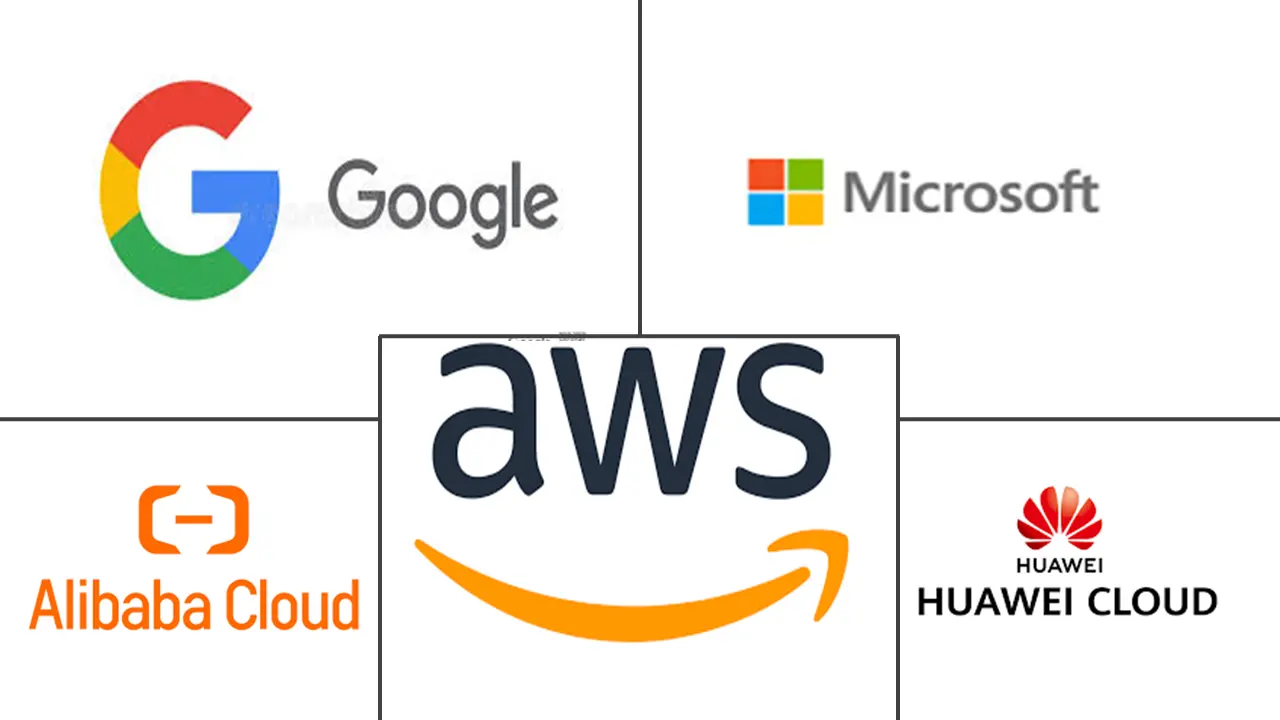Digital Infrastructure Market Size and Share
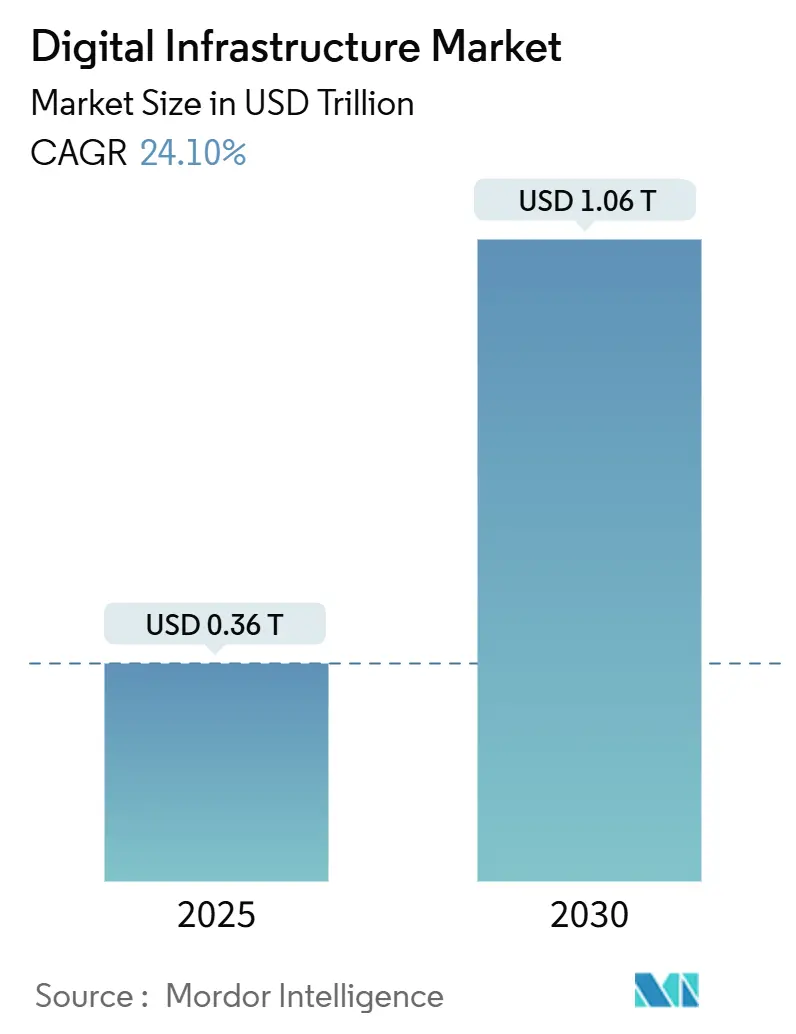
Digital Infrastructure Market Analysis by Mordor Intelligence
The digital infrastructure market size reached USD 360 billion in 2025 and is projected to climb to USD 1.06 trillion by 2030, reflecting a robust 24.10% CAGR that underscores its evolution into a strategic economic pillar. Heightened sovereign-cloud mandates, surging AI workloads that outstrip traditional architectures, and parallel growth in hyperscale and edge facilities are reshaping enterprise deployment strategies. Centralized mega-facilities now concentrate AI model training, while distributed micro-data centers bring sub-10 ms inference closer to users, creating a dual-tier topology that broadens the addressable digital infrastructure market. Grid constraints in major metros further accelerate modular builds, and public incentives—such as the USD 42.45 billion U.S. BEAD program—are catalyzing broadband and cloud investments that enlarge the digital infrastructure market.
Key Report Takeaways
- By deployment model, Public Cloud IaaS led with 41.92% digital infrastructure market share in 2024; Edge/Far-Edge is forecast to expand at a 33.23% CAGR to 2030.
- By infrastructure layer, Data Center Facilities captured 64.75% of the digital infrastructure market size in 2024, while Cloud Compute and Storage is advancing at a 27.90% CAGR through 2030.
- By enterprise size, Large Enterprises controlled 64.51% of value in 2024, whereas Hyperscalers record the highest projected CAGR at 29.55% through 2030.
- By geography, North America held 39.41% share of the digital infrastructure market in 2024; Asia-Pacific is set to grow the fastest at a 29.50% CAGR to 2030.
- By end-user vertical, IT and Telecom accounted for 32.88% share in 2024 and its AI-intensive subsector is rising at a 24.80% CAGR through 2030.
Global Digital Infrastructure Market Trends and Insights
Drivers Impact Analysis
| Driver | (~) % Impact on CAGR Forecast | Geographic Relevance | Impact Timeline |
|---|---|---|---|
| Proliferation of hyperscale and edge data centers | +8.5% | Global, concentrated in North America and Asia-Pacific | Medium term (2-4 years) |
| Accelerating cloud and hybrid adoption across verticals | +6.2% | Global, led by North America and Europe | Short term (≤ 2 years) |
| 5G and fiber roll-out boosting bandwidth demand | +4.8% | Asia-Pacific core, spill-over to North America and Europe | Medium term (2-4 years) |
| Surge in AI/ML workloads demanding specialized compute | +7.3% | North America and Asia-Pacific, expanding to Europe | Short term (≤ 2 years) |
| Grid-constrained regions fast-tracking modular micro-DCs | +3.1% | North America and Europe, emerging in Asia-Pacific | Long term (≥ 4 years) |
| Sovereign-cloud mandates driving localized build-outs | +2.9% | Europe and Asia-Pacific, selective North America | Medium term (2-4 years) |
| Source: Mordor Intelligence | |||
Proliferation of hyperscale and edge data centers
Hyperscale sites now target 100 MW-plus power to host dense AI clusters, whereas edge nodes multiply across secondary cities where land and energy remain affordable.[1]Vertiv Holdings Co., “2025 Hyperscale and Edge Outlook,” vertiv.com Central campuses emphasize liquid cooling and automated operations, while micro-DCs favor self-contained modules that can be commissioned in weeks. Asia-Pacific leads edge capacity, rising from 10,233 MW in 2024 to 19,069 MW by 2028, a 13.3% CAGR that outpaces core builds. Hyperscalers increasingly self-develop to optimize cost and energy mixes, and edge spending—USD 232 billion in 2024—will top USD 300 billion by 2026 as latency-sensitive workloads mature.
Accelerating cloud and hybrid adoption across verticals
Enterprises are moving beyond basic lift-and-shift toward application-native, multi-cloud frameworks that balance sovereignty, latency, and cost.[2]Microsoft Corp., “Cloud-Native Enterprise Architecture,” microsoft.comHybrid setups keep sensitive data on-premise yet burst into public clouds for peak demand, intensifying network interconnect requirements. AWS recorded USD 107.6 billion revenue in 2024, and Microsoft Azure alongside Google Cloud are scaling sector-specific stacks that embed compliance by design. Subscription pricing lowers CapEx barriers and swells total addressable demand in the digital infrastructure market.
5G and fiber roll-out boosting bandwidth demand
National broadband funds such as BEAD (USD 42.45 billion) and the UK’s Project Gigabit (£5 billion) are laying high-capacity fiber that links 50,000+ enterprises directly at 400 Gbps.[3]Lumen Technologies Press Release, “400 Gbps Fiber Expansion Partnership,” lumentechnologies.comCorning-Lumen contracts earmark 10% of global fiber output through 2026, doubling intercity miles that underpin cloud traffic. 5G densification drives edge capacity closer to towers, enabling real-time vehicle telemetry and industrial IoT workloads that enlarge the digital infrastructure market.
Surge in AI/ML workloads demanding specialized compute
The AI Infrastructure Partnership—anchored by BlackRock, Microsoft, MGX, NVIDIA, and xAI—has unlocked an initial USD 30 billion that could scale to USD 100 billion via debt structures.[4]Global Infrastructure Partners, “AI Infrastructure Partnership Expansion,” global-infra.com AI accelerators mandate liquid cooling and high-density power skirts, raising build costs 15-25% over legacy halls yet offering 10-20× performance per watt. Water use averages 6.75 million gallons per MW each year, spurring sustainability retrofits and regional site shifts.
Restraints Impact Analysis
| Restraint | (~) % Impact on CAGR Forecast | Geographic Relevance | Impact Timeline |
|---|---|---|---|
| Escalating energy and water-use constraints | -4.2% | Global, acute in North America and Europe | Short term (≤ 2 years) |
| Data privacy and cross-border compliance complexity | -2.8% | Europe and Asia-Pacific, emerging North America | Medium term (2-4 years) |
| Carrier-neutral colo shortages in secondary cities | -1.9% | North America and Europe secondary markets | Medium term (2-4 years) |
| Volatile GPU supply chain and rare-earth dependency | -3.1% | Global, concentrated on AI builds | Short term (≤ 2 years) |
| Source: Mordor Intelligence | |||
Escalating energy and water-use constraints
Data centers could consume 9.1% of U.S. electricity by 2030, with national demand topping 71 GW by 2027 as AI tasks draw 10–20× more power than conventional workloads. Liquid cooling lifts capital costs but becomes non-negotiable for next-gen GPUs, while drought-prone states curtail industrial water permits, pushing operators toward zero-water pledges such as Microsoft’s 2026 target.
Data privacy and cross-border compliance complexity
GDPR-style mandates in Europe and analogous rules across Asia-Pacific force localized replicas of cloud stacks, fragmenting global architectures and inflating annual compliance overhead 8-12%. Sovereign-cloud frameworks oblige hyperscalers to co-invest with domestic partners, sacrificing scale efficiencies yet broadening the digital infrastructure market in each jurisdiction.
Segment Analysis
By Deployment Model: Edge Computing Reshapes Infrastructure Paradigms
Edge/Far-Edge installations are scaling at a 33.23% CAGR, a trajectory that is redefining how the digital infrastructure market distributes compute capacity. Public Cloud IaaS still commanded a 41.92% digital infrastructure market share in 2024, but workload placement is rapidly balancing across centralized and distributed nodes as firms target latency, sovereignty, and cost gains. Carrier-neutral colo demand rebounds because enterprises value direct peering with multiple clouds while retaining sensitive data controls. Meanwhile, on-premise clusters remain entrenched in regulated sectors, and hybrid/multi-cloud is becoming the new default.
Direct 400 Gbps metro loops such as the Lumen–Google Cloud rollout illustrate how network providers monetize the shift, while modular micro-DC vendors cater to power-constrained metros where traditional builds stall. These patterns position the digital infrastructure market for sustained duplication of capabilities both at core and at edge.
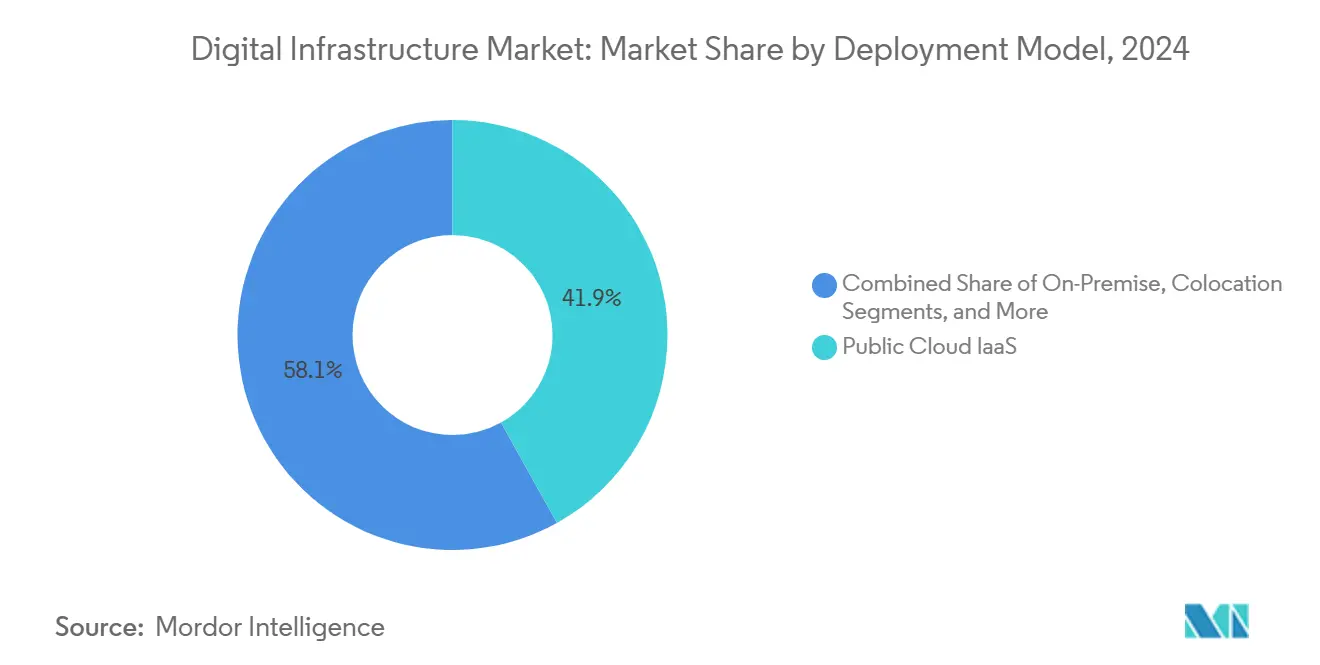
Note: Segment shares of all individual segments available upon report purchase
By Infrastructure Layer: Data Centers Anchor Digital Transformation
Data Center Facilities contributed 64.75% to 2024 revenue, reinforcing the physical backbone of the digital infrastructure market. In contrast, Cloud Compute and Storage is delivering a 27.90% CAGR as enterprises re-platform legacy workloads, turning this layer into the fastest value-accreting segment. High-density racks elevate demand for switchgear, battery systems, and advanced thermal management that incumbents such as Schneider Electric and Vertiv now bundle with AI-ready designs.
The digital infrastructure industry is witnessing an uptick in orchestration software that automates hybrid estates, while AI accelerators and network fabrics emerge as supply-chain pinch points. Schneider’s EUR 18.2 billion H1 2024 revenue, buoyed by data-center energy management, underscores how infrastructure vendors tap this momentum.
By Enterprise Size: Hyperscalers Drive Infrastructure Evolution
Large Enterprises retained 64.51% of spending in 2024, but Small and Medium Enterprises (SMEs) are expanding at a 29.55% CAGR, funneling billions into proprietary campuses that redefine cost curves. Their investments amplify downstream orders for switchgear, chillers, and fiber routes, thereby enlarging the digital infrastructure market. Small-to-mid-sized firms benefit from pay-as-you-grow capacity without CapEx strain, while public agencies ride broadband grants and sovereign-cloud models to modernize legacy IT stacks.
AWS-Intel co-designs of AI fabric chips spotlight the vertical integration wave that characterizes this phase of the digital infrastructure industry. Meanwhile, Dell’s USD 12 billion AI server backlog signals mainstream enterprise appetite for specialized compute.
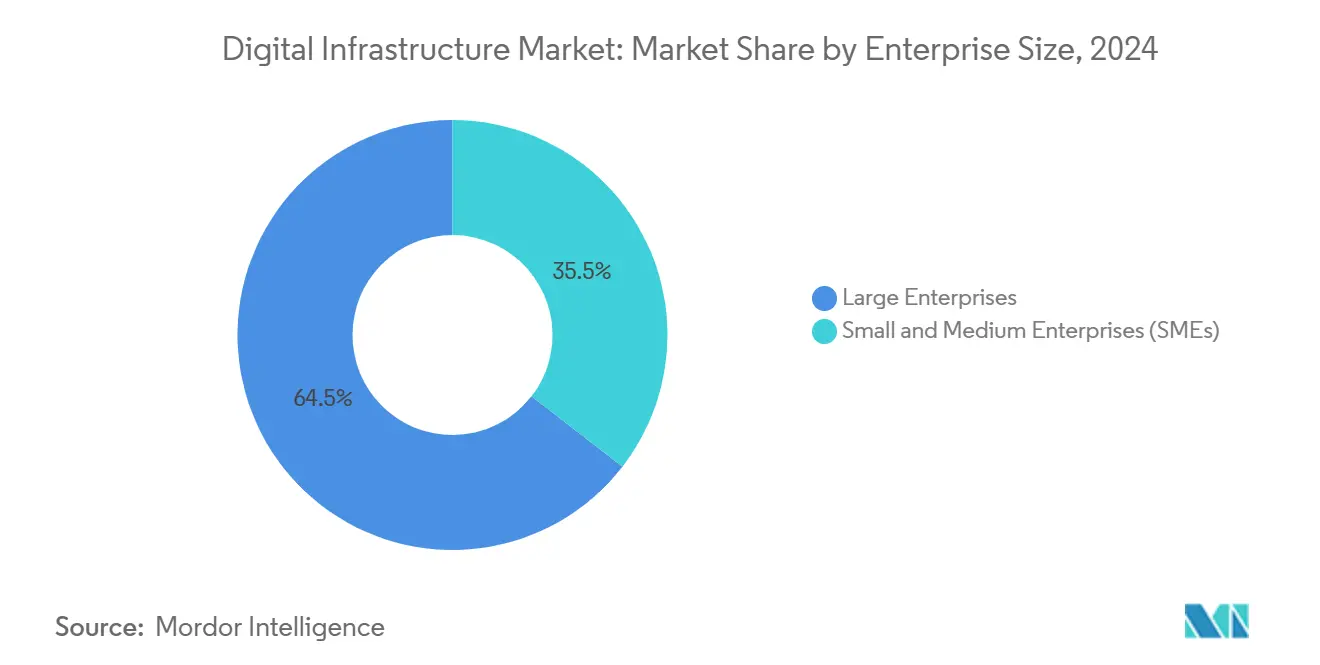
By End-User Vertical: AI Transforms IT and Telecom Dynamics
IT and Telecom kept 32.88% share in 2024 yet its AI-heavy workloads are scaling at 24.80% CAGR, creating sub-segmentation within the wider digital infrastructure market. BFSI accelerates cloud-native core renewals, manufacturing leans on edge analytics for predictive maintenance, and healthcare pours capital into discovery pipelines that need petascale accelerators.
Government and defense agencies opt for sovereign clouds to satisfy strict residency statutes, while media firms adopt cloud-native production pipelines that exploit elastic GPU farms. These domain-specific expansions exemplify how the digital infrastructure market is specialising rather than merely growing in bulk.
Geography Analysis
North America commanded 39.41% of 2024 revenue, sustained by the BEAD broadband initiative and over USD 100 billion of AI infrastructure partnerships that continue to energize the digital infrastructure market. Enterprise appetite for on-shore semiconductor fabs and abundant renewable resources further reinforce the region’s attractiveness. Canada’s CAD 3.225 billion Universal Broadband Fund and Mexican nearshoring trends extend the opportunity landscape into adjacent markets.
Asia-Pacific is the growth engine, advancing at a 29.50% CAGR through 2030. Local governments, from India to Indonesia, offer tax holidays and green-power incentives that magnetize hyperscalers. Google’s USD 1 billion Thai region is forecast to add USD 4 billion to GDP and create 14,000 jobs annually through 2029, exemplifying the multiplier effect on the digital infrastructure market. China scales domestic capacity behind its tech giants, while Japan and South Korea commercialize 5G edge at pace.
Europe shows measured yet steady momentum, driven by sovereign-cloud frameworks and net-zero targets. The UK’s Project Gigabit, France’s data-residency edicts, and Nordic renewable surplus are shaping regional buildouts. Fragmented regulation complicates multinational rollouts but simultaneously fuels demand for specialist compliance hosting, which enlarges local slices of the digital infrastructure market.
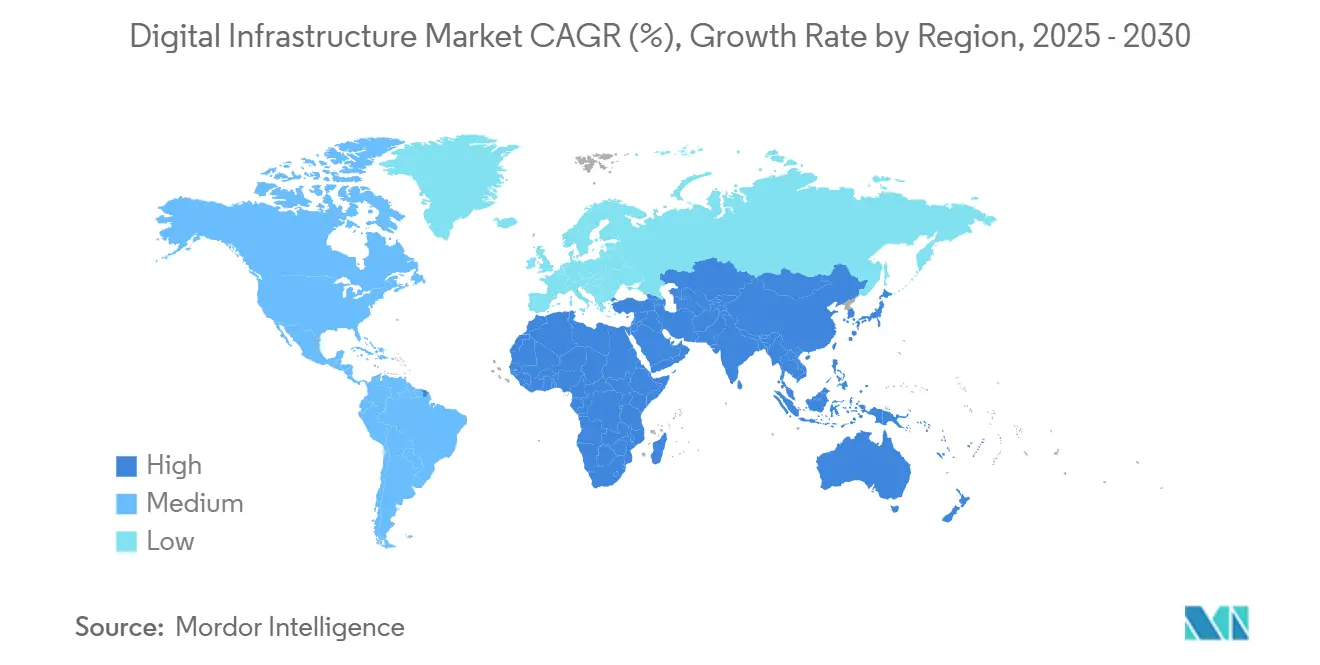
Competitive Landscape
The digital infrastructure market remains moderately concentrated. AWS, Microsoft, and Google dominate hyperscale cloud but collectively leave enough share for regional and niche specialists. Their multi-billion dollar AI clusters challenge colo incumbents, yet also expand total demand for power and cooling vendors such as Schneider Electric and Vertiv. Partnerships—BlackRock’s AI initiative or Intel’s fabrication alliances—define current competitive tactics.
Edge computing, liquid cooling, and sustainability solutions create white-space for innovators. Modular data-center builders deploy in weeks where grids are constrained, while software-defined networking firms like Arrcus orchestrate traffic across multi-cloud topologies. Technology differentiation focuses on AI-ready density, renewable integration, and automated operations, enabling players to command premiums inside specialized pockets of the digital infrastructure market.
Incumbents hedge by acquiring niche capabilities; Schneider’s Motivair buyout augments its liquid-cooling stack, while Vertiv’s investment surge mirrors rising AI pipeline visibility. These maneuvers signal an arms race to own the components that future-proof hyperscale and edge footprints.
Digital Infrastructure Industry Leaders
-
Amazon Web Services
-
Microsoft Corporation
-
Google Cloud Platform
-
Alibaba Cloud
-
Huawei Cloud & Infrastructure
- *Disclaimer: Major Players sorted in no particular order
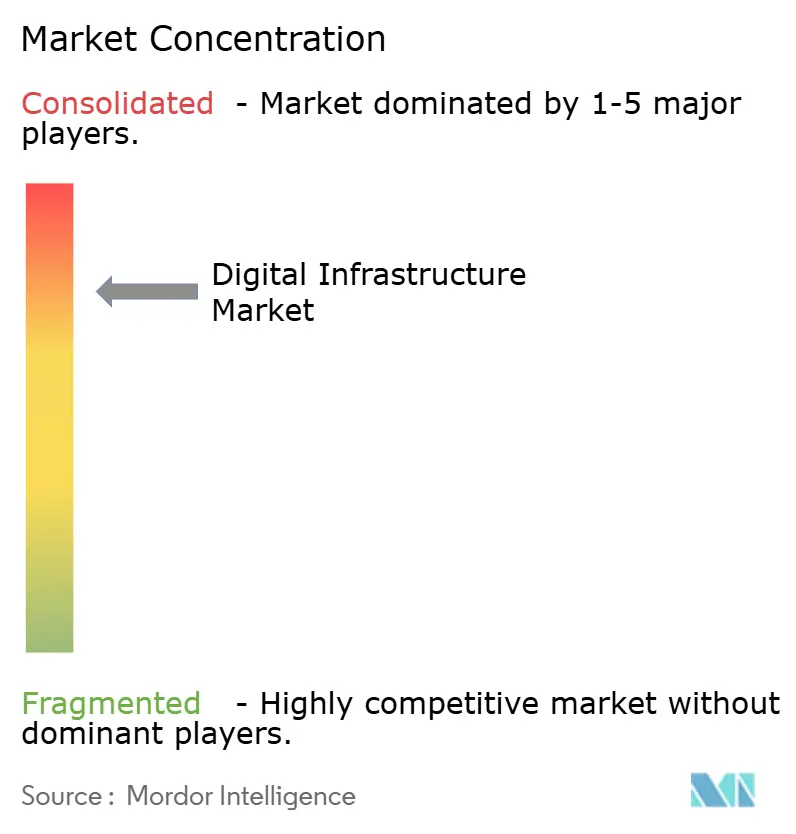
Recent Industry Developments
- March 2025: BlackRock, Global Infrastructure Partners, Microsoft, MGX, NVIDIA, and xAI expanded the AI Infrastructure Partnership, unlocking USD 30 billion in equity with potential to mobilize USD 100 billion total capital.
- January 2025: AWS and Booz Allen broadened collaboration to accelerate cloud migration and generative-AI adoption for U.S. federal agencies.
- September 2024: Google committed USD 1 billion for a data-center and cloud region in Thailand, projected to add USD 4 billion to GDP and create 14,000 jobs yearly through 2029.
- July 2024: Microsoft teamed with Lumen Technologies to pair AI services with 400 Gbps fiber, accelerating edge adoption for millions of customers.
Global Digital Infrastructure Market Report Scope
Digital infrastructure, encompassing data centers, cloud systems, networking tools, and telecom technologies, underpins the delivery of digital services.
The study tracks the revenue accrued through the sale of the digital infrastructure market by various players across the globe. it also tracks the key market parameters, underlying growth influencers, and major vendors operating in the industry, which supports the market estimations and growth rates over the forecast period. The study further analyses the overall impact of COVID-19 aftereffects and other macroeconomic factors on the market. The report’s scope encompasses market sizing and forecasts for the various market segments.
The digital infrastructure market is segmented by deployment type(on-premise and cloud), enterprise size (small & medium enterprises (SMEs) and large enterprises), end-user (it & telecom, BFSI, retail, government, manufacturing, healthcare, and others), and geography (North America, Europe, Asia Pacific, Middle East and Africa, and Latin America). The market sizes and forecasts regarding value (USD) for all the above segments are provided.
| On-Premise |
| Colocation |
| Public Cloud IaaS |
| Hybrid / Multi-Cloud |
| Edge / Far-Edge |
| Data Center Facilities |
| Network Connectivity (Fiber, 5G, Satellite) |
| Cloud Compute and Storage |
| AI Accelerators and Specialized Chips |
| Infrastructure Software and Management |
| Others |
| Small and Medium Enterprises (SMEs) |
| Large Enterprises |
| IT and Telecom |
| BFSI |
| Retail and E-commerce |
| Manufacturing and Industrial |
| Healthcare and Life Sciences |
| Government and Defense |
| Energy and Utilities |
| Media and Entertainment |
| Others |
| North America | United States | |
| Canada | ||
| Mexico | ||
| South America | Brazil | |
| Rest of South America | ||
| Europe | United Kingdom | |
| Germany | ||
| France | ||
| Nordics | ||
| Russia | ||
| Rest of Europe | ||
| Asia-Pacific | China | |
| India | ||
| Japan | ||
| South Korea | ||
| Southeast Asia | ||
| Oceania | ||
| Middle East and Africa | Middle East | U.A.E. |
| Saudi Arabia | ||
| Turkey | ||
| Rest of Middle East | ||
| Africa | South Africa | |
| Nigeria | ||
| Kenya | ||
| Rest of Africa | ||
| By Deployment Model | On-Premise | ||
| Colocation | |||
| Public Cloud IaaS | |||
| Hybrid / Multi-Cloud | |||
| Edge / Far-Edge | |||
| By Infrastructure Layer | Data Center Facilities | ||
| Network Connectivity (Fiber, 5G, Satellite) | |||
| Cloud Compute and Storage | |||
| AI Accelerators and Specialized Chips | |||
| Infrastructure Software and Management | |||
| Others | |||
| By End-user Enterprise Size | Small and Medium Enterprises (SMEs) | ||
| Large Enterprises | |||
| By End-User Vertical | IT and Telecom | ||
| BFSI | |||
| Retail and E-commerce | |||
| Manufacturing and Industrial | |||
| Healthcare and Life Sciences | |||
| Government and Defense | |||
| Energy and Utilities | |||
| Media and Entertainment | |||
| Others | |||
| By Geography | North America | United States | |
| Canada | |||
| Mexico | |||
| South America | Brazil | ||
| Rest of South America | |||
| Europe | United Kingdom | ||
| Germany | |||
| France | |||
| Nordics | |||
| Russia | |||
| Rest of Europe | |||
| Asia-Pacific | China | ||
| India | |||
| Japan | |||
| South Korea | |||
| Southeast Asia | |||
| Oceania | |||
| Middle East and Africa | Middle East | U.A.E. | |
| Saudi Arabia | |||
| Turkey | |||
| Rest of Middle East | |||
| Africa | South Africa | ||
| Nigeria | |||
| Kenya | |||
| Rest of Africa | |||
Key Questions Answered in the Report
What is the current size of the digital infrastructure market?
The digital infrastructure market size stands at USD 360 billion in 2025 and is forecast to reach USD 1.06 trillion by 2030.
Which deployment model is growing the fastest?
Edge/Far-Edge deployments are expanding at a 33.23% CAGR as enterprises push real-time processing closer to users.
How significant is North America’s role in the market?
North America holds 39.41% share, supported by major broadband funding and AI-infrastructure partnerships exceeding USD 100 billion.
Why are liquid-cooled data centers becoming important?
AI accelerators generate high heat densities that air systems cannot handle efficiently, making liquid cooling mandatory and boosting related capital expenditure 15-25%.
Page last updated on:
